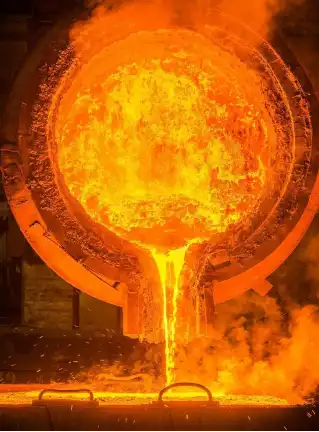
Knowledge
Improving the Metallurgical Quality of Cast Steel (Part One)
The Importance of Adequate Deoxidation in Steelmaking

Improving the metallurgical quality of cast steel, deoxidation treatment is a crucial step. The following is an analysis of the importance of deoxidation in the metallurgical process of cast steel:
I. The Necessity of Deoxidation
1. The Harmful Effects of Oxygen on Cast Steel:
Formation of Porosity: During the solidification of molten steel, as the solubility of oxygen decreases significantly with the drop in temperature, the precipitated oxygen reacts with carbon in the molten steel to form CO bubbles. If these bubbles remain in the steel, they become porosity, seriously affecting the density and mechanical properties of the cast steel.
Aggravation of Hot Cracking Tendency: When the oxygen content in the molten steel is too high, FeO and FeS will form a low-melting-point eutectic (FeO·FeS) upon meeting, which is distributed in a film-like manner on the grain boundaries, making the cast steel prone to hot cracking during solidification.
Formation of Non-metallic Inclusions: Oxygen can react with various elements to form oxide inclusions. If these inclusions remain in the steel, they will significantly reduce the plasticity, impact toughness and other mechanical properties of the cast steel.
2. Ensuring the quality of the cast billet: Deoxidation treatment can significantly reduce the oxygen content in steel and decrease the formation of non-metallic inclusions, thereby ensuring that the cast billet has a good solidification microstructure and mechanical properties.
II. Deoxidation Methods and Their Effects
1. Precipitation deoxidation method:
Principle: Add block-shaped deoxidizers (such as ferrosilicon, ferromanganese, aluminum, etc.) directly into the molten steel. The deoxidizers react with the oxygen in the molten steel through precipitation reactions, generating deoxidation products that are insoluble in the molten steel.
Effect: The precipitation deoxidation method has a fast deoxidation speed, but the removal of deoxidation products may affect the deoxidation effect. By optimizing the type and amount of deoxidizers, as well as enhancing the stirring of the molten steel and the adsorption effect of the slag layer, the removal efficiency of deoxidation products can be improved.
2. Diffusion deoxidation method:
Principle: Utilize the diffusion behavior of oxygen in the molten steel. Sprinkle powdered deoxidizers (such as ferrosilicon powder, aluminum powder, etc.) onto the slag surface to reduce the oxygen content in the slag, disrupting the solubility equilibrium of oxygen between the slag and the molten steel, causing the oxygen in the molten steel to diffuse into the slag.
Effect: The diffusion deoxidation method does not contaminate the molten steel, but the deoxidation speed is relatively slow. By optimizing the composition and thickness of the slag layer, as well as enhancing the contact and stirring between the molten steel and the slag layer, the efficiency of diffusion deoxidation can be improved.
III. Selection and Application of Deoxidizers
1. Common Deoxidizers:
Silicon Iron: Silicon has a strong affinity for oxygen, and the deoxidation product SiO₂ is a high-melting-point solid particle. Although it is difficult to remove, silicon iron is still an indispensable deoxidizer in the steelmaking industry.
Manganese Iron: Manganese is a weak deoxidizer, but manganese in solid solution form in steel can strengthen it and improve its mechanical properties. Therefore, manganese iron is often used in combination with other deoxidizers.
Aluminum: Aluminum is the most commonly used strong deoxidizer, with strong deoxidation ability. The deoxidation product Al₂O₃ is a solid particle that is easy to float and be removed. However, aluminum has a much lower specific gravity than molten steel and is prone to oxidation and loss. Corresponding measures need to be taken to improve its utilization rate.
Composite Deoxidizers: Such as silicon-manganese alloys, silicon-manganese-aluminum alloys, etc. By combining multiple deoxidizing elements, better deoxidation effects can be achieved.
2. Application of deoxidizers:
Select appropriate deoxidizers and deoxidation methods based on the type of steel and the smelting process.
Strictly control the addition amount and timing of deoxidizers to avoid excessive or premature addition, which may result in difficult removal of deoxidation products or fluctuations in the composition of the molten steel.
Strengthen the stirring of the molten steel and the adsorption effect of the slag layer to improve the removal efficiency of deoxidation products.
IV. The Impact of Deoxidation on the Metallurgical Quality of Cast Steel
1. Enhance the purity of steel: Through deoxidation treatment, the oxygen content and non-metallic inclusions in steel can be significantly reduced, thereby improving the purity of steel.
2. Improve the mechanical properties of steel: Deoxidation treatment can reduce the formation of defects such as porosity and hot cracking, and enhance the mechanical properties of steel, including plasticity and impact toughness.
3. Stabilize the composition of molten steel: Reasonable deoxidation treatment can control the oxygen content and inclusion morphology in molten steel, which is conducive to stabilizing the composition of molten steel and ensuring the quality of cast billets.
Vigor has more than 18 years experience on castings. If you have any question and demand of products development or improve your supply chain, please feel free to contact us at info@castings-forging.com



